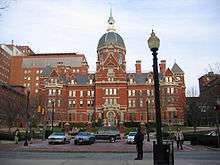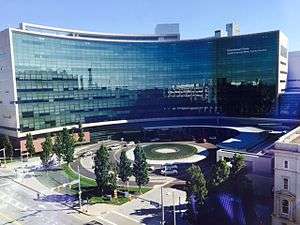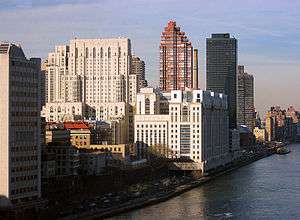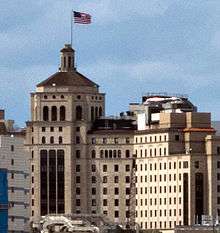Medical centers in the United States
- This article discusses the major medical centers in the U.S. For all hospitals, see List of hospitals in the United States. For a general discussion about U.S. health care see Health care in the United States.
Medical centers in the United States are conglomerations of health care facilities including hospitals and research facilities that also either include or are closely affiliated with a medical school. Although the term medical center is sometimes loosely used to refer to any concentration of health care providers including local clinics and individual hospital buildings, the term academic medical center more specifically refers to larger facilities or groups of facilities that include a full spectrum of health services, medical education, and medical research.
The major medical centers represent the crown jewels of health care in the United States. They vary greatly in their organization, the services they provide, and their ownership and operation.
Overview
In the United States, ownership of the health care system is mainly in private hands, though federal, state, county, and city governments also own certain facilities. Many major hospitals, generally the backbone of any medical center, are non-profit and many of these have their origins in religious organizations. Despite their non-profit status, affiliation with private ventures and major medical schools often allows them to maintain state-of-the-art facilities and services. The non-profit hospital's share of total hospital capacity has remained relatively stable (about 70%) for decades.[1] There are also privately owned for-profit hospitals as well as government hospitals in some locations, mainly owned by county and city governments.
Major medical centers provide many specialized services, some even containing multiple specialized hospitals and clinics each dedicated to specific types of patients and/or services. Additionally they are centers of medical education, centers of medical research, and incubators for medical innovation and technology. A given medical center may include a medical school in the same complex as the rest of the facilities or may be closely affiliated with a medical school on a nearby campus. Similarly a given medical school may be closely associated with multiple tightly linked hospital campuses which function to some degree as a unit though the group may not be referred to as a single medical center (e.g. the Harvard Medical School network of teaching hospitals).
There are about 1,100 teaching hospitals in the United States. Approximately 375 of the larger institutions belong to the Association of American Medical Colleges’ Council of Teaching Hospitals and Health Systems (COTH). COTH teaching hospitals train about 75 percent of residents yearly and provide more than 40 percent of all hospital charity care in the nation.
Major medical centers
Although any rankings of medical centers are highly subjective, this section describes some of the largest and most prominent centers in the nation. Note that the rankings and importance of individual hospital facilities may be different from the medical centers that they belong to.
National Institutes of Health

The National Institutes of Health (NIH) are an agency of the United States Department of Health and Human Services and are the primary agency of the United States government responsible for biomedical and health-related research.
The NIH's research is divided into two parts: the Extramural Research Program is responsible for the funding of biomedical research outside the NIH, while the Intramural Research Program (IRP) is the internal research program of the NIH, known for its synergistic approach to biomedical science. Intramural research is primarily conducted at the main campus in Bethesda, Maryland, immediately adjacent to the Walter Reed National Military Medical Center and right outside Washington, D.C.. The NIH campus houses the divisions of intramural research for eighteen of the twenty national institutes, including the National Institute of Allergy and Infectious Diseases, the National Cancer Institute, and the National Institute of Mental Health, as well as the National Library of Medicine, while the adjoining Walter Reed campus houses the military medical center, the Uniformed Services University of the Health Sciences, the Armed Forces Radiobiology Research Institute, the National Intrepid Center of Excellence, and the Joint Pathology Center.
Johns Hopkins

The Johns Hopkins University School of Medicine, located in Baltimore, Maryland (USA), in addition to operating a major medical school, operates the Johns Hopkins Hospital, which consists of both a teaching hospital and biomedical research facility. It was founded using money from a bequest by philanthropist Johns Hopkins. The Johns Hopkins Hospital and the Johns Hopkins School of Medicine are the founding institutions of modern American medicine and are the birthplace of numerous traditions including "rounds," "residents" and "housestaff".[2] The Johns Hopkins Hospital is the birthplace of many medical specialties including neurosurgery, urology, endocrinology, pediatrics, cardiac surgery[3] and child psychiatry.[4][5][6] It is widely regarded as one of the greatest hospitals in the United States and the world.[7] It has been ranked by U.S. News and World Report as the best overall hospital in America for 20 consecutive years.[8][9][10]
Mayo Clinic
Mayo Clinic is a non-profit organization and internationally renowned group medical practice headquartered in Rochester, Minnesota. Its College of Medicine and Science includes the Mayo Clinic School of Medicine, the Mayo Clinic Graduate School of Biomedical Sciences, and the Mayo Clinic School of Graduate Medical Education. It has clinical, research, and educational facilities in Rochester, Minnesota, in addition to Scottsdale and Phoenix, Arizona, and Jacksonville, Florida. Mayo Clinic partners with a number of smaller clinics and hospitals in Minnesota, Iowa, and Wisconsin, an organization known as the Mayo Clinic Health System.
Mayo Clinic pays medical doctors a fixed salary that is unaffected by patient volume.[11] This practice is thought to decrease the monetary motivation to see patients in large numbers and increase the incentive to spend more time with individuals. Salaries are determined instead by the marketplace salaries for physicians in comparable large group practices.
The Mayo Clinic campuses in Rochester form the largest integrated medical center in the world.[12]
Massachusetts General

Massachusetts General Hospital (also known as Mass General or MGH) and Harvard Medical School in Boston, Massachusetts collectively represent one of the oldest medical education and research centers in the nation. Massachusetts General itself is owned and operated by Partners HealthCare (which also owns Brigham and Women's Hospital and North Shore Medical Center among others). MGH is part of the consortium of hospitals which operates Boston MedFlight and is a member of the Dana-Farber/Harvard Cancer Center. Mass General is also the primary teaching hospital for Harvard Medical School.
The hospital has 1,051 beds and admits over 45,000 patients each year. The surgical staff performs over 34,000 operations yearly and hospital handles over 1 million outpatients each year at its main campus, as well as its six satellite facilities in Boston at Back Bay, Charlestown, Chelsea, Everett, Revere, and Waltham. In 2003, MGH was named the state's first Magnet hospital by the American Nurses Credentialing Center, a subsidiary of the American Nurses Association. In 2012 MGH was ranked the #1 hospital in the United States by U.S. News and World Report, for the first time supplanting the Johns Hopkins Hospital, which held first place for 21 consecutive years.[8]
Texas Medical Center

The Texas Medical Center is the largest medical center in the world with one of the highest densities of clinical facilities for patient care, basic science, and translational research.[13] Located in Houston, the center contains 50 medicine-related institutions, including 21 hospitals and two specialty institutions, two medical schools, six nursing schools, and schools of dentistry, public health, pharmacy, and other health-related practices. All 50 institutions are not-for-profit and constitute some of the most highly regarded institutions in the country, including: M.D. Anderson Cancer Center, Texas Children's Hospital, The Texas Heart Institute, The Methodist Hospital and Baylor College of Medicine. The center is where one of the first and largest air ambulance services was created and where a successful inter-institutional transplant program was developed. More heart surgeries are performed at the Texas Medical Center than anywhere else in the world.[14]
Cleveland Clinic

The Cleveland Clinic is a multispecialty academic medical center located in Cleveland, Ohio. Currently regarded as one of the top hospitals in the United States,[8] the Cleveland Clinic was established in 1921 by four physicians for the purpose of providing patient care, research, and medical education in an ideal medical setting. One of the largest private medical centers in the world, the Cleveland Clinic saw more than 2,800,000 patient visits in 2005, with almost 70,000 hospital admissions.[15] Patients arrive at the Cleveland Clinic from all 50 states and more than 100 nations. The Cleveland Clinic's approximately 1,700 salaried staff physicians represent 120 medical specialties and subspecialties and is ranked among the top four hospitals in America.[8] The Cleveland Clinic has ranked number one in America for cardiac care for 15 years in a row.[16]
NewYork-Presbyterian Hospital

NewYork-Presbyterian Hospital is a prominent university hospital system in New York City, composed of two medical centers, Columbia University Medical Center and the Cornell University Weill Medical Center.
New York-Presbyterian Hospital, chartered as "The New York and Presbyterian Hospital" by New York State in 1996, was formed in 1998 with the merger of two large, previously independent hospitals, the New York Hospital and Presbyterian Hospital. The NYPH system includes a variety of outlying hospitals that had previously been acquired by NYH or Presbyterian; these hospitals stretch throughout the five boroughs, Westchester County, Long Island and New Jersey. NYPH is now the largest private employer in New York City.
The two medical schools remain essentially autonomous, though there is increasing cooperation and coordination of clinical, research, and residency training programs. NewYork-Presbyterian Hospital is one of the most comprehensive university hospitals in the world, with leading specialists in every field of medicine.
University of Pennsylvania Health System

University of Pennsylvania Health System includes the nation's first teaching hospital, Hospital of the University of Pennsylvania (HUP), and the nation's first hospital, Pennsylvania Hospital. It operates under the direction and auspices of Penn Medicine in Philadelphia, PA. HUP alone is ranked as the 9th-best overall hospital in the United States by U.S.News & World Report in 2010.[17] Although it is not a part of Penn Health System, the Children's Hospital of Philadelphia(CHOP) is also on the same campus and it engages in many collaborative efforts. CHOP's physicians serve as the pediatrics department of Penn's School of Medicine.
University of Pittsburgh Medical Center

The University of Pittsburgh Medical Center (UPMC) is headquartered in Pittsburgh, Pennsylvania and is closely affiliated with its academic partner, the University of Pittsburgh, which ranks third in the nation in the number of total NIH-sponsored research awards and fifth for the total dollar amount of NIH-sponsored funding.[18] UPMC is one of the largest medical center systems in the world with more than 35 hospitals, 8,000 licensed beds, and 600 outpatient sites in Pennsylvania, Ohio, and New York, as well as locations overseas. Appearing on US News & World Report's honor roll of the top hospitals for over 15 years,[19] it was the site of the creation of the first polio vaccine by Jonas Salk, helped to develop emergency medicine under Peter Safar, and pioneered organ transplantation under the direction of Thomas Starzl, at one time boasting the largest and busiest organ transplantation program in the world.[20] A fully integrated health care system that includes its own health insurance and commercial services divisions, UPMC has exported its clinical and administrative expertise and technologies around the world, including the ISMETT organ transplantation center in Sicily, a hospital and cancer centers in Ireland, and partnerships in China, Colombia, Italy, Japan, Kazakhstan, Lithuania, Singapore, and the United Kingdom.[21]
UCSF Medical Center

The UCSF Medical Center is a world-renowned teaching hospital and center of biomedical research located in San Francisco, California, with campuses in Parnassus Heights, Lower Pacific Heights and Mission Bay and is affiliated with the University of California, San Francisco. The UCSF Medical Center was ranked the nation's 5th-ranked hospital and 1st-ranked hospital in California according to U.S. News & World Report.[22] In 2017 It is one of the leading hospitals in the United States and the UCSF School of Medicine has been the site of various breakthroughs in all specialties of medicine, including the discovery of oncogenes, prions as the etiologic agents of transmissible spongiform encephalopathies, first in-utero fetal surgery, development of catheter ablation therapy for tachyarrhythmias, and the discovery and treatment of surfactant deficiency in neonatal respiratory distress syndrome (RDS). UCSF's faculty has included five Nobel laureates, 31 members of the National Academy of Sciences and 69 members of the Institute of Medicine. The Mission Bay campus currently under construction contains the largest biotechnology construction in the United States as well as the 183-bed UCSF Benioff Children's Hospital and new cancer and women's specialty hospitals.
UCSF Medical Center is affiliated with the University of California, San Francisco, which in 2012 was ranked second among world universities in clinical medicine and pharmacy by the Academic Ranking of World Universities.[23] The medical center has ranked among the top 10 hospitals in the United States for 11 of the last 12 years by U.S.News & World Report.[24]
Ronald Reagan UCLA Medical Center
The Ronald Reagan UCLA Medical Center is a hospital located on the campus of the University of California, Los Angeles in Los Angeles, California.
UCLA Medical Center has research centers covering nearly all major specialties of medicine as well as dentistry and ophthalmology, and is the primary teaching hospital for the David Geffen School of Medicine at UCLA. The hospital's emergency department is certified as a level I trauma center for adults and pediatrics.
It is rated as one of the top three hospitals in the United States and is the top hospital on the West Coast according to US News & World Report.[8] The hospital has been ranked in the top twenty in 15 of the 16 medical specialties ranked by the US News ranking. Ten of those specialties were ranked in the top ten.
See also
References
- ↑ David, Guy (Sep 2003). "The Convergence between For-Profit and Nonprofit Hospitals in the United States" (PDF). https://pdfs.semanticscholar.org. University of Chicago. External link in
|website=(help) - ↑ General Psychiatry Residency Program Archived 2009-09-23 at the Wayback Machine., Johns Hopkins web site
- ↑ Something the Lord Made - An HBO Film, Johns Hopkins web site
- ↑ "JHM History" Johns Hopkins Medicine, Accessed August 7, 2008.
- ↑ Great Works: 100 Years of Philanthropy in Service of Hopkins Psychiatry, Johns Hopkins web site
- ↑ Division of Child and Adolescent Psychiatry, Johns Hopkins web site
- ↑ Henderson, Randi ; Marek, Richard: : Here is My Hope: A Book of Healing and Prayer: Inspirational Stories of Johns Hopkins Hospital, Amazon.com
- 1 2 3 4 5 "Best Hospitals Honor Roll". U.S. News & World Report. 2008-07-10. Retrieved 2009-05-02.
- ↑ U.S. News & World Report's Best Hospitals, Johns Hopkins Medicine
- ↑ THE JOHNS HOPKINS HOSPITAL TOPS U.S. NEWS & WORLD REPORT "HONOR ROLL" 19TH YEAR IN A ROW, Johns Hopkins Medicine web site, July 16, 2009
- ↑ "Doctors On Salary, One Key To Mayo's Success". NPR.
- ↑ http://www.mayoclinic.org/rochester/ Mayo Clinic in Rochester, MN
- ↑ Industry Guide: Health Care | Greater Houston Partnership Archived 2008-10-15 at the Wayback Machine.
- ↑ "Texas Medical Center - About the Texas Medical Center". Archived from the original on 2007-08-10. Retrieved 14 Feb 2009.
- ↑ Cleveland Clinic Overview
- ↑ Cleveland Clinic Ranked as One of America's Top Hospitals, Cleveland Clinic, 16 July 2009
- ↑ America's Best Hospitals: the 2010–11 Honor Roll
- ↑ "NIH Research Portfolio Online Reporting Tools (RePORT): NIH Awards by Location & Organization". National Institutes of Health. June 13, 2016. Retrieved June 19, 2016.
- ↑ "2011 U.S. News & World Report Rankings". UPMC. Archived from the original on 2013-02-09. Retrieved 2012-02-22.
- ↑ Gruson, Lindsey (1985-09-16). "Center for Transplants Aids Pittsburg Ascent". The New York Times. New York, NY. Retrieved 2012-02-22.
- ↑ "UPMC International". UPMC. 2016. Retrieved June 19, 2016.
- ↑ "2017-18 Best Hospitals Honor Roll and Overview" U.S. News & World Report (Aug 8, 2017)
- ↑ "Academic Ranking of World Universities in Clinical Medicine and Pharmacy- 2012". Center for World-Class Universities of Shanghai Jiao Tong University. 2012-10-15.
- ↑ "UCSF named top 10 hospital for 11th consecutive year". UCSF. 2007-07-15. Retrieved 2007-07-15.